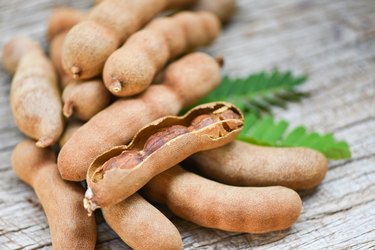
Claims abound about the use of tamarind in diabetes management, but information on the connection between tamarind and diabetes is very limited. Could downing a glass of tamarind juice or adding a cup of tamarind pulp to your dinner really help blood glucose control? The answer remains unclear.
The Lowdown on Tamarind
Video of the Day
Tamarind is a tropical tree that produces a pod-like edible fruit. Popular in tropical climates, tamarind is a common ingredient in many dishes traditionally found in countries including Bangladesh, India, Sudan and Nigeria, according to a November 2019 review in Food Science & Nutrition. It's also used as a traditional medicine in many tropical countries for various conditions.
Video of the Day
While tamarind is bursting with nutrients like fiber, calcium and magnesium, it is quite high in natural sugar. According to the U.S. Department of Agriculture (USDA), one cup of tamarind pulp provides 75 grams of carbohydrates, 47 grams of which are in the form of natural sugar — equivalent to about 12 teaspoons.
Despite this sugar content, the glycemic index of tamarind — which is the ranking of the effect a carbohydrate-based food has on your blood sugar after being eaten — is low, according to data published in the 2015 January/March issue of Food Science and Technology.
Tamarind juice is often touted on social media as a "health drink," and tamarind-containing items like paste and syrup also are available for purchase. These items, though, may have added sugars, and they may not have a low glycemic index ranking.
However, the fruit that comes from the tamarind tree is chock-full of vitamins and minerals and is a naturally low-fat food. According to data published in Scientific Reports in June 2015, tamarind is a powerful anti-inflammatory and has antioxidant properties, features that are beneficial for people living with diabetes.
Read more: The Benefits of Sweet Tamarind
Can Tamarind Help with Diabetes Management?
"When it comes to tamarind and diabetes, there are two sides to this fruit's story," explains Casey Seiden RD, CDE, a dietitian in New York City and author of Meal Prep for Two. "Tamarind pulp, the sticky substance that surrounds the seed found inside the tamarind pod, is actually filled with a lot of nutrients that can be quite beneficial for blood sugars," she says.
"Tamarind is rich in magnesium, a mineral most Americans are deficient in, which plays a crucial role in blood sugar regulation by increasing insulin sensitivity. The pulp also contains potassium and polyphenolic compounds, such as flavonoids, that are both important for decreasing inflammation and improving cardiovascular function, which is of great importance in people living with diabetes," Seiden explains.
However, there is limited data supporting the use of tamarind to support diabetes outcomes, and the data are all based on animal studies.
For instance, a February 2014 study published in the Pakistan Journal of Medical Sciences found that several phytochemicals extracted from tamarind drops lowered blood glucose among rats with experimentally induced hyperglycemia. In another study, published in Pharmaceutical Biology in March 2013, the flavonoids extracted from the seeds of tamarind appeared to increase insulin release in the animals that were studied.
The Bottom Line
Tamarind can be a healthy addition to a diet, but because of its natural sugar content, too much can be a cause of concern for those living with diabetes as it may increase blood glucose levels. Although there have been some animal studies suggesting that tamarind intake may have a positive impact on the management of blood glucose and diabetes symptoms, the same may not hold true for humans.
Experts say to simply enjoy tamarind in moderation if you like the taste and to not turn to it as a diabetes cure-all until results are available from additional research involving humans.
Read more: List of Foods Good for Prediabetics
- Casey Seiden, MS, RD, CDN, CDE, dietitian, New York City, and author, Meal Prep for Two
- U.S. Department of Agriculture: My Food Data: “Tamarinds”
- Food Science and Technology: “Glycemic Index and Glycemic Load of Tropical Fruits and the Potential Risk for Chronic Diseases”
- Food Science and Nutrition: “Effect of Tamarind (Tamarindus indica L.) Seed on Antioxidant Activity, Phytocompounds, Physicochemical Characteristics, and Sensory Acceptability of Enriched Cookies and Mango Juices”
- Pakistan Journal of Medical Sciences: “Antihyperglycaemic Activity of the Stem-Bark Extract of Tamarindus Indica L. on Experimentally Induced Hyperglycaemic and Normoglycaemic Wistar Rats”
- Pharmaceutical Biology: “Anti-Inflammatory Action of Tamarind Seeds Reduces Hyperglycemic Excursion by Repressing Pancreatic β-cell Damage and Normalizing SREBP-1c Concentration”
- Scientific Reports: “Tamarind Seed (Tamarindus indica) Extract Ameliorates Adjuvant-Induced Arthritis via Regulating the Mediators of Cartilage/Bone Degeneration, Inflammation and Oxidative Stress”
- Food Science & Nutrition: "Tamarind: A Diet-Based Strategy Against Lifestyle Maladies"
Is this an emergency? If you are experiencing serious medical symptoms, please see the National Library of Medicine’s list of signs you need emergency medical attention or call 911.